The Back End of the Bus
The Back End of the Bus
Of the thousands of photos of buses now on the web and in print, photos of the back of vehicles are very much in the minority.
Yet many a subtle change in design can be just as easily gleaned from photos of the rear as much as photos of front three quarters nearside or offside or full side on.
There was an evolution in the design of rear platform windows on double deckers from two bay to single bay in the 1930s and 1940s. Some operators narrowed their windows or opaqued the offside-most window so ladies' ankles could not be seen descending stairs. Manchester had a different ploy, it used to place an advert or information poster in the window. Eventually almost everyone went to one window, of various widths except ECW which had two windows, and two shapes at different times, on the Bristol Lodekka.
In 1953 both BMMO and Manchester Corporation received batches of all Leyland PD2s. Both had the same
features which I think were specific only to these bodies viz: reduced depth upper deck rear emergency exit
windows compared to the rest of the Leyland bodyshop output of the time AND rear route number boxes in
bulges on the mid decks exterior panel. The "bulges" on the Manchester bodies were much larger and more
flared. Were there others? Was this indicative of an overall design modification which would have appeared
on further vehicles had the Leyland bodyshop not been earmarked for closure? Certainly Trent's last all
Leyland PD2s delivered in 1954 had the reduced depth windows.
BMMO photo here
Trent photo here
The original MCW bodied Atlanteans/Fleetlines had spectacle type lower deck rear windows above the bustle, reminiscent of the rear upper deck emergency exit windows on Burlingham's standard body. Sometime in the early 1960s MCW decided to follow other bodybuilders and use a single window.
Alexander used two bay upper deck emergency exits. Eventually they went to a single window but there was a time when operators could specify either.
Roe had a similar situation and some operators, such as Ashton under Lyne had both options.
In 1963 North Western took two batches of 36' Reliances with Willowbrook body, one batch in bus red and cream, the other in a unique split red cream red livery - much to the annoyance of enthusiasts who looked forward to them appearing in black, cream and red. From the front and side they looked like standard BET bodies (Reliance photo here). The rear was something different and I've not been able to find a photo. The window was a standard rear window from the 1958 Willowbrook/BET design but the rounded dome had been stopped short above the window with a distinct cut in "lip", as opposed to a "peak" which was placed over the wrap round rear window which became the new BET standard.
Were these batches the only vehicles with this design and, if so why are photos so hard to find?
There are probably dozens of other examples.
I've been an aviation photographer for over 40 years and one of the first things a serious collector learns is, where possible, take both sides of the aircraft as there are almost certainly going to be differences, if only in the colour scheme.
Perhaps bus photographers should take a hint and not ignore the back end of the bus. It isn't always what the old saying suggests and can give clues to developments in styling the rest of the body does not have.
Phil Blinkhorn
10/2012
26/10/12 - 16:40
This style of body with the back end that you describe was only built by
Willowbrook in 1963. North Western had the greatest number, but there were others.
Hebble had four Leopard PSU3/1R's - 102-105 (SCP 562-565), County Motors had two similar ones - 103/104 (YCX
538/539), and East Midland had four Reliance 2U3RA's - L396-399 (396-399 RRR) and ten PSU3/1R's - L400-409
(400-409 RRR). There may well have been others, I have a feeling Poole's of Alsager Bank may have had one.

The rear window was actually not that from the 1958 style BET body but was larger with a slightly squarer outline, as shown on this rear view of East Midland's L397 at their Chesterfield depot.
John Stringer
27/10/12 - 06:32
Thanks for the photo and information John. As far as the window is concerned it is
somewhat less rounded than the version on the 30ft vehicles but I was given to understand by NWRCC's
engineers at the time that it was a widened version to suit the extra two and a half inches in width.
I always considered the design more attractive than the standard BET wrap round window and peaked roof.
Phil Blinkhorn
27/10/12 - 06:34
I do take some pictures of the back ends and insides of buses particularly if they are rare or unusual. However as an N gauge modeller my first question is does this vehicle exist in my scale. If it does - such as the Bedford OB - then I will take something to help fellow modellers, although bus enthusiasts like to see the front in my opinion.

Here's a picture taken at Warminster showing slight differences in the rear of 2 x Bedford OBs owned by the same company. Motivation for taking this shot is that I come from Somerset and the vehicle type is already available in N gauge as finished model and as white metal kit.
Ken Jones
27/10/12 - 06:38
On the Manchester Leyland-bodied PD2s I got the impression that the reason for the bulge around the rear route number box was lack of space in the stairwell. I didn't know about the Midland Red bulges, but I remember some earlier Southport all-Leyland PD2s with the rear number and destination in a protruding box, and again the stairwell seemed too cramped to have accommodated it. Thankfully one of these has been preserved, and can be seen here.
Peter Williamson
27/10/12 - 09:29
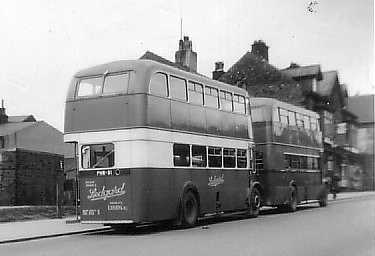
Here is one of my early box camera snapshots taken in about 1953. The location is
the Samuel Ledgard stand in Ilkley for departures to Leeds via Otley or via Guiseley. I can quote the exact
time from knowledge of the regular duty which the nearest vehicle always operated when new. It is a Saturday
lunchtime at 13:22/13:25 when the service journey to Guiseley and Leeds was always duplicated, as were
others, thanks to the large number of passengers still travelling in those pre- decline days.
My main reason for taking the picture was to show the unmistakable "family resemblance" between the prewar
and postwar Leyland bodies. The duplicate bus is JNW 288, one of three 1940 TD7s operated. At the rear is
PNW 91, one of three PD2/12s purchased new in February 1952 - Samuel Ledgard's last purchase before his sad
demise two months later in the April, the famous business continuing successfully under the Executors until
October 14th 1967, when it was sold as there were no family members remaining to run it and some menacing
legal changes to the Industry were looming.
Chris Youhill
27/10/12 - 11:10
Peter, I can see why a two line display plus numbers would need space which would cramp a stairwell but, in the case of Manchester, and particularly BMMO, there was just a simple number blind arrangement which, in the case of Manchester, was replicated fleetwide including on earlier Leyland bodied PD2s without blocking the stairwell. If your contention is correct it would indicate that the staircase had been modified on late model Bailey style bodies.
Phil Blinkhorn
27/10/12 - 13:19
I agree with John about the back end of Willowbrooks. As to the Leyland bodies, the flared and bulging number boxes also appeared on the rear (centre) of Sheffield 656-667 (1952 PD2/10s). I think this would therefore have been a Leyland thing. All the many Leyland bodies for Sheffield before these had flush fitting boxes in an eccentric position - at the nearside above the cut-away of the open platform. [This could still fit in with comments about space.] 656-667 had standard two piece Leyland emergency windows, though, not the smaller version.
David Oldfield
Messrs Heaps and Eyres attributed the bulge to the need for more space on the
stairwell on the Manchester bus.
Could this have been because this batch was the first Faringdon body for MCTD with 28 seated downstairs as
opposed to 26 previously. If the overall length of the bus was unchanged might there have been a slightly
lengthened lower saloon by means of moving the stairwell and platform bulkhead back to accommodate four
seater (rather than three seater) longitudinal seats over the rear wheel arches. Just speculating!
Orla Nutting
28/10/12 - 05:52
Willowbrook and Weymann at first continued with the original 1958-style almost semi-elliptical rear window on their 1962 BET 36-footers - using a revised flat-fronted design (as per the Midland Red LS18 class etc.). Marshall then entered the fray later that year using the same old style rear, but were the first to incorporate the curved BET front screen and peaked dome. Willowbrook then switched to the style shown on the East Midland bus in 1963 and with the new front. In early 1964 all adopted the curved rear screen (which Park Royal had first used on a DP/Coach version for East Kent/Aldershot & District and Birch previously) and rear peaked dome, and the classic 1960's BET 36-foot bus was complete.
John Stringer
28/10/12 - 09:16
Orla, I've also seen the reference in "The Manchester Bus" though it isn't really
helpful. What is helpful is your memory.
Manchester's previous PD2s with Leyland bodies were PD2/1 which "The Leyland Bus" says were 26 ft long.
The batch I refer to were PD2/12 at, again according to "The Leyland Bus", 27 ft long. They had
accommodation for an extra two on the lower deck and this was by means of an extra space on the longitudinal
seats. As an extra 16-20 inches is needed when designing a seat, this is where the pressure was put on the
staircase width. They could really have done with an extra 6 inches in body length.
I well remember my first ride on one of these and I know the exact date - 21 August 1953 - which means it
was on one of 3330-3341. The trip was with my Dad on the 125 Limited Stop from Piccadilly to Crown Point,
Denton. I was just over a month over 6 at the time and the trip stuck in my memory for a number of reasons.
The bus was almost brand new and had that new bus smell. We actually sat on the longitudinal seats which
were the longest I'd seen. As we passed London Rd fire station we had to pull in to let fire engines go by.
At Ardwick Green we were delayed and then had to travel on the wrong side of the road as the southbound side
of the A6 was blocked by fire engines and hoses dealing with the fire at Jewsbury and Browns which was well
alight.
Once on Hyde Rd the driver decided to make up time and the bus had an impressive turn of speed.
For many years these were my favourite MCTD vehicles and its only a pity that the body from 3363 that was
fitted to the chassis of 3494 didn't survive into preservation.
Thanks John for a very comprehensive round up of the design changes to the BET single decker rear end.
Phil Blinkhorn
28/10/12 - 10:07
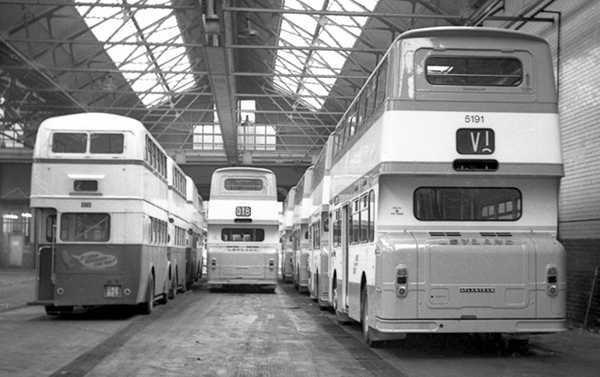
The reference to the Sheffield OWB-series Leyland-bodied PD2s has prompted me to
dig out the attached photo, which fits in very well with the theme anyway.
Taken on 24th April 1971 it shows on the right the final batch of Atlanteans ordered by Oldham Corporation.
These were delivered to SELNEC and this shot shows the biggest difference between them and the predecessors
as they didn't have shrouds above the engine. You may notice all these buses have no registration plates -
that's because they were delivered with the wrong registrations (for the most prominent vehicle BBU 191J
instead of ABU 191J) and were waiting delivery of the correct ones.
The vehicles on the left are some of those that were replaced by these Atlanteans, including some of the
varied selection of Leyland-bodied PD2s that had ended up in Oldham in various ways. The most prominent is
476, one of sixteen secondhand PD2s bought in 1965/6, none of which was to receive a SELNEC fleetnumber. 476
was one of four PD2/10s from Sheffield which had been refurbished and repainted by Neepsend and has the
prominent rear number display referred to earlier in this thread. It entered service in Oldham in the
crimson and white livery but received the pommard and cream livery shown here in the very early days of
SELNEC. At the front of the row is similar 477, one of the last few vehicles in the fleet still in the
crimson livery.
Between the two are 471 (DBN 329), another of the sixteen purchases and originally Bolton 426, this being a
PD2/4. The other is 5922 (EDB 556), an ex-Stockport PD2/1 which was transferred to Oldham in the early days
of SELNEC and also received the pommard and cream livery. At first it was numbered 5202, renumbered as if
its Stockport fleet number (302) was an Oldham number.
David Beilby
28/10/12 - 11:45
The indicator box on the back of the OWB registered Sheffield PD2 is not unlike the Manchester version but the Manchester version was larger and placed centrally in the mid decks panel.
Phil Blinkhorn
29/10/12 - 07:01
With reference to John's summary of BET body styles, there is at least one more
variation:
Trent's Willowbrook bodied PSU3 Leopards 200-223 (200-223CCH) entered service in April and May 1963,
and had the 1958 style rear end, with the BET wraparound windscreen at the front. Were these unique to
Trent?
Another variation was in 1965, Trent took delivery of Willowbrook bodied PSU3s 232-251(ECH232-251C).
232-241 had long windowed bodies, to imitate/emulate the Alexander Y types delivered in 1964(some hope!)
242-251 had 'normal' side windows. However, all 20 had the wrap round screen at the rear, but with a rounded
dome rather than the peak previously used.
(I think the variations of the BET body could form a topic on its own).
To go further off subject, the curved front and rear screens used on the BET design were used on the
front of the Nottingham standard double decker design, from the Fleetlines delivered in 1966 through to the
final AN68s delivered in 1982.
Bob Gell
29/10/12 - 10:56
On a lot of Duple and Plaxton coaches from the early 70's the front and rear windscreens were interchangeable. Does anyone know of any more?
Ronnie Hoye
29/10/12 - 10:56
There were many variants of the BET style body, and as you say Bob, it is worthy of further study. I have been interested in the subject for a long time and have recently been attempting collect as much information and photos as I can. I would like one day to do an article for this site, the greatest problem being to find suitable non-copyrighted photos to illustrate it with.
John Stringer
29/10/12 - 12:48
Just to clarify what I said, I'm not saying that Duple windscreens would fit Plaxton or vice versa, what I meant is that the front screen on some coaches could in some cases be used as a rear on the same vehicle.
Ronnie Hoye
29/10/12 - 12:50
Regarding David Beilby's comments about the Oldham Atlanteans arriving with the
incorrect registrations.
I remember when these buses arrived from Roe, and I was walking through the Garage (being employed at Oldham
Depot at that time) to look at them, in all their pristine glory.
When I saw them I thought that the registrations looked familiar, and after a moment or two realised that
191 had the same registration as a car my Aunt had just bought BBU 191J.
I quickly sought out the Chief Engineer and reported my findings to him, and a check was made in the records
to find out the correct numbers, and I was found to be correct - ABU being the right mark.
So the number plates were removed, as seen in David's picture and new ones ordered from Roe's.
Stephen Howarth
29/10/12 - 15:02
The photo of the Oldham Atlanteans raises an interesting point. Oldham had route letters as well as route numbers but the letters were abandoned and numbers substituted on April 1 1968. As the photo was taken on 14 April 1971, and the nearest bus shows the letter V and the one in the middle seems to show D and possibly B (it may be 8) the question is why did SELNEC, by then in operation for some 18 months, have new vehicles supplied with letters they didn't need?
Phil Blinkhorn
29/10/12 - 15:03
John - I think you should be encouraged to produce an article on the BET style
body;
I feel sure relevant photos could be made available by contributors to this site,
myself included, if you were to list the ones you needed for the article.
Bob Gell
30/10/12 - 06:23
Copyright Reading & Co.
Phil Blinkhorn's article, "The Back End of a Bus" reminds us that we should take/publish photos of rears. It reminded me that I hold this rear-end photo of Crossley/Reading No 11 (EBK 23), the first of the first delivery on 1948 - withdrawn 1963). They had very stylish back IMHO.
Chris Hebbron
30/10/12 - 06:27
The Oldham photo confirms my memory of the OWB PD2s. What I found puzzling was the rear view of the Atlanteans. The AN68 was not introduced until 1972 (J was a 1971 mark) but these vehicles have the distinctive AN68 engine cover with vents at the top. These are presumably PDR1/1a specials (the interim design bought in numbers by London Country). If so, I had forgotten that they had the same engine cover as the AN68.
David Oldfield
30/10/12 - 14:55
Anyone really desperate to see the back end of one of the Manchester PD2's with a raised profile on the rear indicator blind can catch a quick glimpse of one disappearing up Portland Street on the 57/77/83 (impossible to say) after about 1'20" of this interesting 60's colour video of the Manchester bus scene, especially trolleybuses. www.youtube.com/watch
Orla Nutting
30/10/12 - 15:58
Re the engine covers on the Oldham Atlanteans. The vehicles were ordered by Oldham prior to the formation of SELNEC. Bus Lists on the Web shows the batch as follows (the GO number is the Roe body number):
GO7004 ABU188J Ld PDR1A/1
7004615 H43/31D 5/1971 SELNEC
5188
GO7005 ABU198J Ld PDR1A/1
7100711 H43/31D 5/1971 SELNEC
5198
GO7006 ABU189J Ld PDR1A/1
7004616 H43/31D 5/1971 SELNEC
5189
GO7007 ABU194J Ld PDR1A/1
7100341 H43/31D 5/1971 SELNEC
5194
GO7008 ABU196J Ld PDR1A/1
7100476 H43/31D 5/1971 SELNEC
5196
GO7009 ABU199J Ld PDR1A/1
7100712 H43/31D 5/1971 SELNEC
5199
GO7010 ABU190J Ld PDR1A/1
7100003 H43/31D 5/1971 SELNEC
5190
GO7011 ABU193J Ld PDR1A/1
7100136 H43/31D 5/1971 SELNEC
5193
GO7012 ABU197J Ld PDR1A/1
7100632 H43/31D 5/1971 SELNEC
5197
GO7013 ABU191J Ld PDR1A/1
7100004 H43/31D 5/1971 SELNEC
5191
GO7014 ABU192J Ld PDR1A/1
7100135 H43/31D 5/1971 SELNEC
5192
GO7015 ABU195J Ld PDR1A/1
7100475 H43/31D 5/1971 SELNEC 5195
It's interesting to note the seemingly random way the registrations/fleet numbers
were allocated. It's likely that the registrations follow the chassis numbers and some chassis passed
through the works out of sequence.
The registration suffix J ran from 1/8/1971 to 31/7/1972.
As far as the engine covers are concerned it could well be that SELNEC had them changed to match its large
AN68 order to standardise the spares situation. Leyland certainly had small stocks at the Chorley spares
centre in early 1972, If SELNEC did order the change it makes the question of why the letters remained on
the number blinds more intriguing.
Phil Blinkhorn
31/10/12 - 06:49
It was not only this batch of Oldham Atlanteans that featured the vents on the
engine cover - the previous ten dual-door Atlanteans 178-182 (SBU 178-182G) and 5183-5187 (WBU 183-187H)
also had them. These all had O.680 engines but so also did the last batch of single-door Atlanteans 161-171
(OBU 161-171F) which had no vents. 5183-7 were new in the very early days of SELNEC and delivered
un-numbered, with SELNEC fleet number transfers (as opposed to Oldham's pressed number plates) being added
before entry into service.
I do wonder whether the blinds had letters simply because no-one changed the specification after route
letters were abolished. They had no formal use (there were no services with letter prefixes of suffixes) but
I'm sure were put to a variety of unofficial uses.
David Beilby
01/11/12 - 06:46
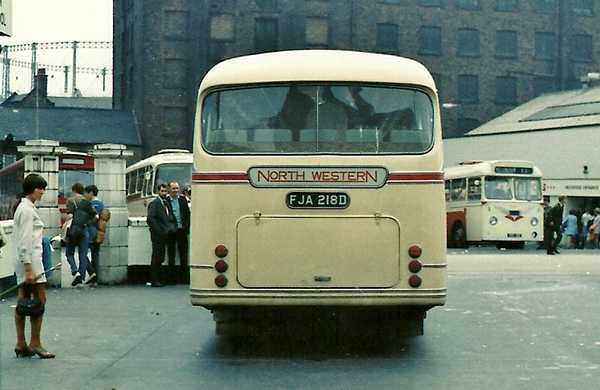
North Western Road Car Co Ltd, Alexander C49F bodied Leyland Leopard PSU3/4R - FJA
218D.
It was new in 1966 and was transferred to Crosville Motor Services in January 1972, on the split up of the
Company.
This must be the best back end of a bus EVER.
Stephen Howarth
01/11/12 - 09:58
The photo of the NWRCC Alexander Y body back end brings back memories.
As an aviation enthusiast in Manchester in the 1960s, London Airport was a "mecca". Whilst I could get there
once or twice a year courtesy of Dad, by the time I was 16 in 1963, more frequent visits were called for,
either for a few days staying with relatives or a day return trip.
The "best" way of getting there was on the BEA Vanguard and there was a student standby fare available for
�5 return and I could sometimes afford this.
When I couldn't NWRCC offered a �2/8/6d return fare if the overnight services were used. Whilst this
entailed a Tube train and a bus ride to complete the journey, the fare was still well under �2/15/0d.
I made the journey many times between 1963 and 1965 when I got my own car. One early trip was on one of the
1962 batch of 36ft Leopards but the rest were on the Y bodied coaches.
Departure was around 11.30pm (no 24hr clock departures then) when a number of vehicles, depending on season
and demand, would depart. The route number was X5 and there was a suffix letter.
There were various routes to exit Manchester depending on the suffix letter. In those days there were only
short stretches of the M6 open. The route I regularly used was to Altrincham, Knutsford, Congleton,
Newcastle under Lyme, Stoke, Stone to Birmingham where a tea break was taken around 2.00am. The A45 was then
followed to Coventry then onto the M1 (now the M45) then down the M10, as the M1 got nowhere near London,
then down the A6 into London and Victoria coach station.
Arrival in London was around 6.00am. The return would follow the reverse route with similar timings. As
other sections of the M6 were opened they were used as appropriate but it was 1971 before the whole motorway
was opened.
The vehicles were equipped with forced air ventilation, 49 seats with a slight recline and reading lights.
They were reasonably well insulated and had two speed rear axles. Whenever the chance arose the high speed
ratio was engaged - it engaged with a distinctive "clunk" - and, in the days before the 70mph limit, they
were capable of over 75mph.
Sometimes a relief driver would be carried and he would take over at Birmingham. Most people managed to
sleep for at least part of the journey but the thought of being on a coach doing that sort of speed when
awake, let alone asleep, now gives me the "willies" as I was on a coach many years later on a private hire
when the driver fell asleep on the M1 at speed and we were lucky to be able to wake him before he ploughed
into some roadworks.
The young lady in the smart "two piece" also reminds me that most people on board were well dressed and
there was a wide cross section of passengers of all ages.
Phil Blinkhorn
Just to clarify, the journey from Birmingham to London was on the M1 but what is now the M45 was then signed as the M1 between Dunchurch south of Coventry and the M1 proper.
Phil Blinkhorn
21/11/12 - 14:08
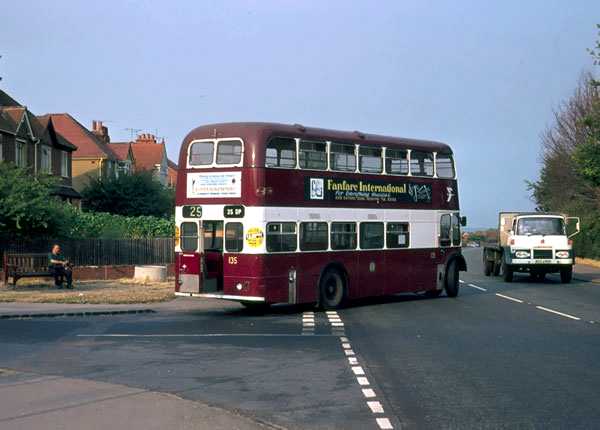
Copyright Alan Murray-Rust
Rather than the more usual offside emergency exit, Reading Transport specified a door at the rear of the bus, for both double and single deck vehicles. This probably stems from the original decision to fit even rear-entrance buses with platform doors, resulting from the the MoT requiring a secondary exit in the event of the bus falling on its nearside. Whether or not the ensuing practice was established straightaway, I have no idea, but certainly by the time I joined the undertaking in 1971 it was a standing requirement for the door to be open when reversing at any of the appropriate termini. The conductor was required to guide the driver from outside the bus, using a whistle which was part of uniform issue. The practice was also invoked for one man operation, although in this case the driver had no assistance. This view, from August 1976, shows Dennis Loline 135 with East Lancs body reversing off Henley Road into All Hallows Road. The manoeuvre was tricky in the dark, as the terminal stop was in a layby just inside the poorly lit All Hallows Road, so you had to reverse round a bit more than 90 degrees, then straighten the bus up before you ran into the shelter alongside the layby, remembering to pull up before hitting the large tree at the end of the layby. This terminus was shown on blinds as Donkin Hill; this was an earlier terminus, named after a road rather than an area, just a few hundred yards short of the later one, but the name was never changed.
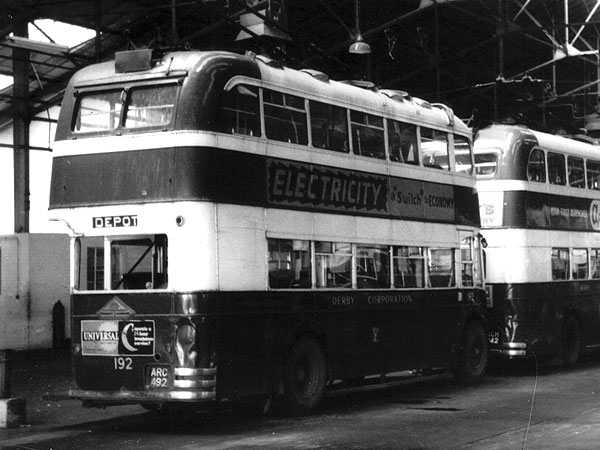
Copyright Alan Murray-Rust
Derby Corporation specified a set of chrome bumpers for the rear of their buses and trolleybuses, certainly as late as the final batch of Roe-bodied trolleybuses. The lowest continued across the width of the rear and there were two (later one) short bumpers to protect the offside corner. Although not clear in this picture, the corner of the bodywork behind the bumpers was concave, so that in the event of a bump, the bumpers would not crumple into the corner itself. Whether there was a specific problem in mind is not clear, but the picture shows that the idea was not particularly effective; the panel above the bumpers is well dented, and this was by no means the only bus to sport damage in this location. This is 192, a Sunbeam F4/Brush trolleybus of 1948 in Ascot Drive Depot in April 1966.
Alan Murray-Rust
22/11/12 - 07:36
I don't know whether it was after this, but after bringing Derby 111 home for preservation in 1970 (see the photo under the Coventry Daimler EVC 244 thread), it had to go up a narrow farm track on a hill. We set off up there and then became aware of it grounding at the rear. We looked at it and thought 'Oh No!"., then carried on in a low spirit to park the bus up. Imagine our amazement when we looked and the damage had disappeared! Turns out Derby had gone for rubber corner panels - the photograph perhaps makes it obvious why.
David Beilby
24/11/12 - 06:59
Just catching up on this thread after a while. First, Phil and Orla may be
interested to know that Manchester 3368 still exists, unrestored, in the care of the SELNEC Preservation
Society, bearing scorch marks from where one of my own failed attempts at preservation spontaneously
combusted next to it in a farmer's field in Lancashire.
Bob mentions that the front and rear curved screens of the BET single decker were used on the front of
Nottingham double deckers. In fact this became a standard option on Northern Counties bodied double deckers,
with varying degrees of success, possibly among the best being those delivered to Southdown. Similarly the
front and rear screens of the Alxander Y type were used on the front of Alexander bodied Atlanteans and
Fleetlines.
On the subject of interchangeability of front and rear screens, I'm pretty sure that certain Strachan bodies
of the 1960s - possibly including the Pacesaver II - used the BET front screen at the back as well as the
front, but, as ever, rear-end views are conspicuous by their absence.
Peter Williamson
25/11/12 - 09:56
Whilst looking for something completely different, I came across this picture and though...this has to be an entrant for the most worrying design competition! Argghh!!! www.flickr.com
Richard Leaman
25/11/12 - 11:26
I saw those buses in East Berlin in the 1980s they were Hungarian built Ikarus. As
a back end of ugliness they rate with the front end of Northern's Tynesider.
On this page there's another Ikarus used in the GDR which seems to bear some family resemblance: transpressnz.blogspot
Phil Blinkhorn
25/11/12 - 15:34
I've done a bit more digging and can identify the type as an Ikarus 66 which was
produced as both a town bus, with sliding vent windows and as an express bus with fixed windows. Here is the
express version: wikipedia.org - Ikarus 66 The vehicle looks far better from this angle.
Here is a mini article on the Ikarus 66 europeforvisitors.com
Designed in 1952 and produced between 1955 and 1973 it was rear engined and shared many features with the
Ikarus 55 coach.
Powered by an 8.275 litre water cooled Csepel D-614 diesel, the GDR imported the type from 1957 and, along
with the Ikarus 55 imported 8350 examples.
Phil Blinkhorn
27/11/12 - 07:15
See what you mean about the back of the Ikarus Richard. Brings a whole new meaning to the question "Does my bum look big in this?". At least in this case the reply of "Yep!" would not be likely to result in a slap across the face.
Brendan Smith
29/11/12 - 07:29
Looking at the length of that rear overhang, Brendan, you'd get more than a slap in the face if you stood too close when it was turning sharply!
Peter Williamson
30/11/12 - 08:51
Back in the mists of my childhood, long before I had any inkling that I would
become a bus enthusiast, our family had a nickname for coaches like this. We called them 'flying buses', due
to the similarity with an aircraft tailplane. Nothing else in the bus/coach world merited such an an
accolade, which is tribute to the distinctiveness of the Harrington Dorsal Fin.
This example was photographed at the Audawn Coaches premises on 24 September 1972 during an enthusiast trip.
It was a special target as it was thought to be possibly the last remaining example of a dorsal fin still in
service. It is an example of the Mk 4 Wayfarer body, which was the last design from Harrington on which the
fin was an option - not, in my view, the most attractive design from the Harrington stable. The vehicle was
the third of a batch of four Tiger Cubs (PSUC1/2) delivered, as the registration would suggest, to the well
known firm of Gliderways of Smethwick in 1958, a loyal customer of Harrington; body No.2002.
Does anyone know how many dorsal fin coaches have made it into preservation? I know of the Lymer's Regal III
and the Silver Star Tiger Cub - are there any others?
Alan Murray-Rust
30/11/12 - 13:11
In partial answer to your question Alan I know of at least one other dorsal fin body that is preserved. This is Charlies Cars of Bournemouth Albion Valiant P70 LJ 9501 which dates from 1934 and carries a postwar Harrington body It can be viewed on the HCVS Charabanc Trip 2011 gallery.
Chris Hough
30/11/12 - 16:11
I know of one other dorsal-finned Harrington coach in preservation. KYD 151 - an AEC Regal III 6821A was new to Scarlet Coaches, Minehead. I believe it used to belong to either David Hoare or Colin Shears, but was loaned to the Mersey & Calder Bus Preservation Group (Halifax branch) in the mid 1970's. It arrived in a yellow and cream livery but was beautifully repainted by its temporary custodian in Scarlet Coaches' livery and rallied for a while. I remember it being taken down to a rally in Cardiff, and driving it all the way back from Chepstow to Halifax. It was lovely to drive, though a bit tedious on the long motorway drag.
10 minutes later
I'd no sooner pressed the Submit button after my previous comment, when I found
another Harrington Dorsal Fin Coach on another site.
JYC 855 is a Leyland PS1 delivered 1948 also to Scarlet Coaches, Minehead (t/a Scarlet Pimpernel), and is
now part of the Roger Burdett collection. It can be seen at this link the photo is taken by our friend Ken Jones.
Thinking about it, is there not also a Scarlet Coaches bonneted Leyland Comet as well ?
John Stringer
08/02/13 - 10:59
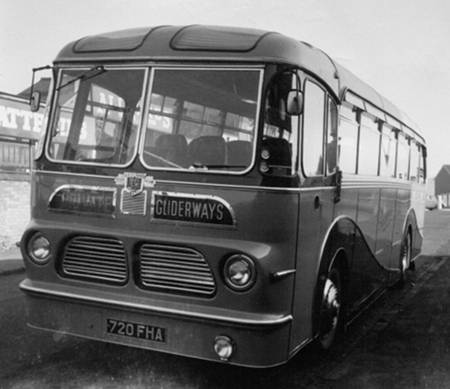
Here is 720 FHA coach again whilst in service with its original owners Gliderways, note that modifications to its side trim have been made since this shot was taken which can be seen in the later colour photo above.
William Parker
09/02/13 - 16:36
There is a list of all known preserved Harrington vehicles at www.thcoachwork.co.uk
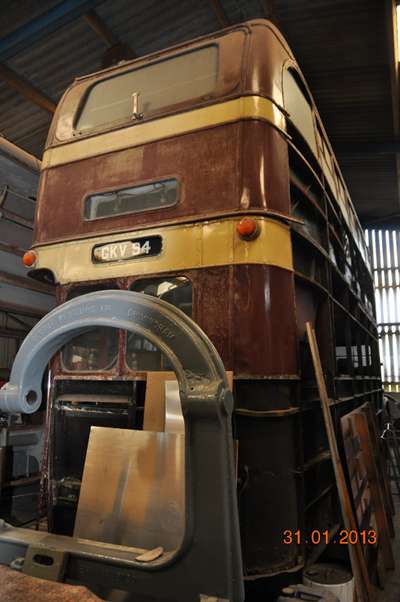
and I attach a picture of the back end of a Daimler bus awaiting restoration.
Ken Jones
11/02/13 - 06:45
There are 11 dorsal finned coaches in preservation-the maximum I have ever seen together is 7 at the 2007 Harrington Gathering.
Roger Burdett
11/02/13 - 13:20
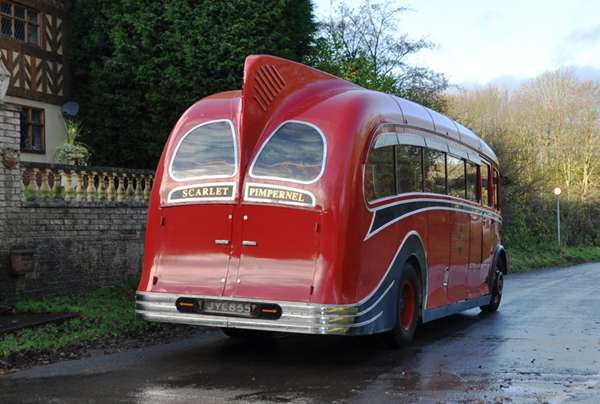
I'm able to join 2 threads in this discussion by showing the back end of JYC 855 complete with dorsal fin. Picture taken near Fillongley, Warwickshire on 25/11/12
Ken Jones
19/02/13 - 06:19
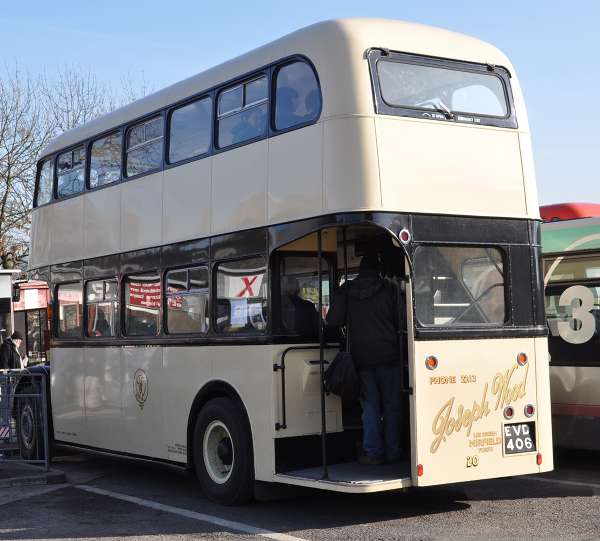
Here's another example of a back end of a bus especially as this vehicle has featured on another thread on the site recently.
Ken Jones
19/02/13 - 16:01
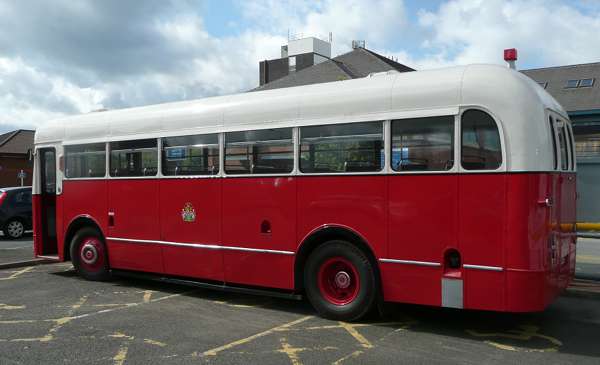
This is a side and back view of a Crossley bodied (one of the last) 1958 Leyland
Tiger Cub, fleet #403 of Stockport Corporation that has recently been restored.
The profile of the body has variously been likened to both the AEC Monocoach and to London RF's in
publications over the years, not surprisingly as it would have been built on Park Royal frames.
More surprising is the plaque on the dashboard which suggests that the bus was originally fitted with a 5
spd box (it now has a 3 spd Albion box) as the vehicle was rarely required to travel beyond the town's
border.
Orla Nutting
19/02/13 - 18:14
The Stockport Tiger Cubs were fitted with five speed constant mesh boxes. As I understand it, first was only used for starting on hills or climbing out of Mersey Sq for St Petersgate when well laden. I was told that top speed in fifth was never more than around 38-40 mph.
Phil Blinkhorn
20/02/13 - 06:08
One feature of the Tiger Cub that wasn't apparent for over 50 years was that under the Tiger Cub badge lay an AEC triangle.
Orla Nutting
20/02/13 - 13:32
The finding of the AEC badge is interesting, given the moulding on which the Tiger
Cub badge was placed is 100% AEC Monocoach/Park Royal.
Whilst the bus looks to be beautifully restored, the front wheel nut guard rings were removed on delivery
so, for historic accuracy, they shouldn't have been replaced though the bus looks much better for them.
These Tiger Cubs always sounded very different from the North Western PSUC1/1s. Were they fitted with the
375 engine which became standard in 1958 as against the 350, standard until that year (the 350 was an option
until 1961/2)?
Phil Blinkhorn
20/02/13 - 15:33
I believe, but am not certain, that it was fitted with a 350 engine, which blew on
it's Weston-Super-Mare circular duties whilst with Steve Morris' Quantock Motor Services.
It now has an ex-MCTD Tiger engine.
Orla Nutting
20/02/13 - 16:50
Orla, It will certainly sound different now!!
Phil Blinkhorn
21/02/13 - 06:57
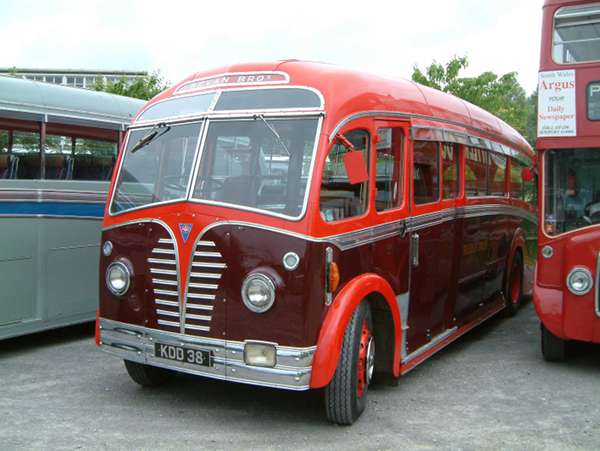
Ref the correspondence on surviving vehicles fitted with the Harrington dorsal fin body. Another candidate is the superb AEC Regal III of Nick Helliker ex Soudley Valley
Andrew Charles
21/02/13 - 11:10
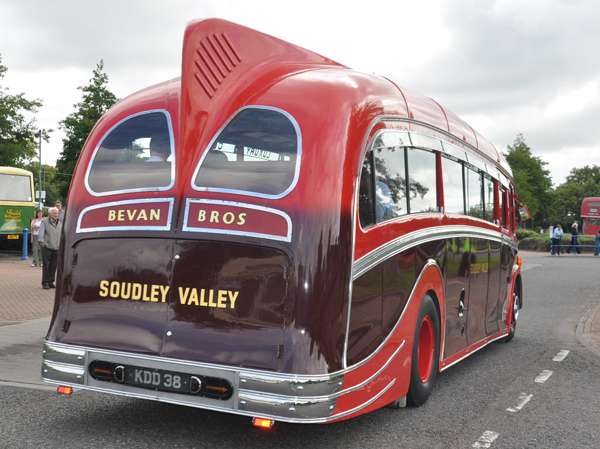
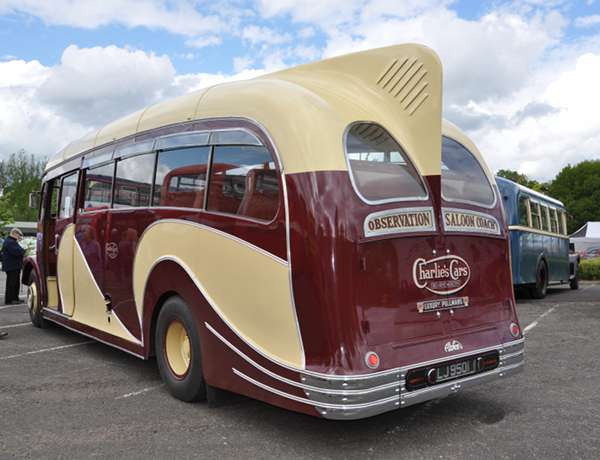
Here is the back end of KDD 38 which recently went on site plus the very attractive LJ 9501.
Ken Jones
19/03/13 - 13:07
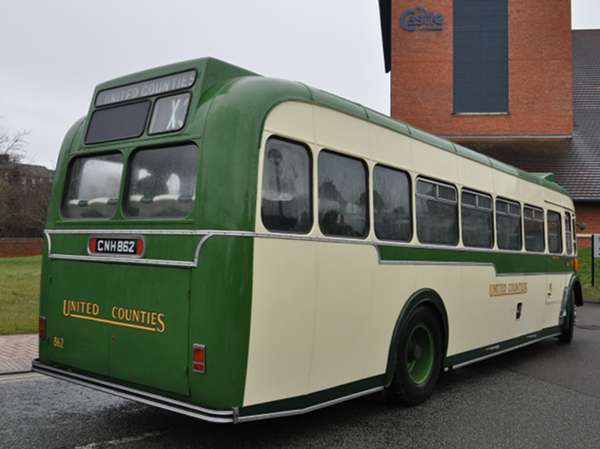
Here are a couple of pictures taken by me in Wellingborough Sunday 17th March for 'The Back End of the Bus' thread.
Ken Jones
23/03/13 - 09:17
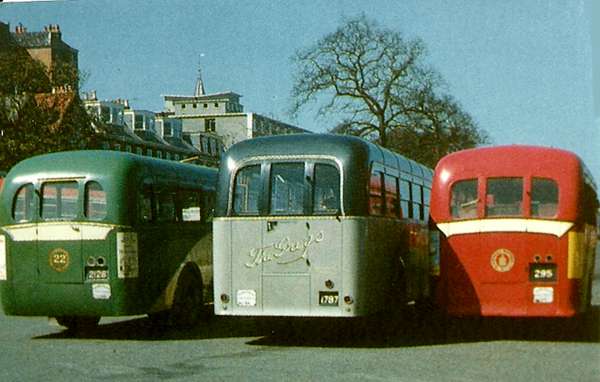
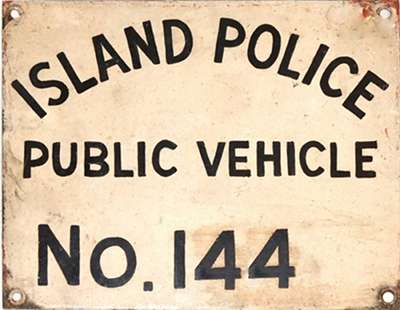
Far left, GUERNSEY RAILWAY Co. Ltd., Hougue a
la Perre, (later Piquet House), St Peter Port.
Guy Vixen - Reg No. 2126, Fleet No.22.
It had Police Plate 144, of which a photo is attached.
It was new in July 1947 and had a Duple B35F body, being withdrawn in September* 1968.
Middle, WATSON'S GREYS, C.R. Watson, Watson's Garage, "The Greys" Les Cornus, St Martin. Albion Victor FT39AN - Reg No. 1787, Police Plate 84. It was new in June 1954 and had a Reading B36F body. It was withdrawn in February 1978 and sold to Guernsey Railways where it became their Fleet No.20. It was then sold in to preservation in 1980 as 898 FUF, and later used by Island Coachways for Vintage Tours of the Island. A picture can be seen of 1787 in service at St Peter Port on flickr at:- www.flickr.com/one and also in preservation at www.flickr.com/two
Right, GUERNSEY MOTORS Ltd., 6 Fountain Street, (later Piquet House), St Peter Port. This is an Austin CXB - Reg No. 295, and had Fleet No.5 in that fleet, and was issued with Police Plate 177. It was new in August 1948, and had a Thurgood** B32F body. This bus was later reseated to B33F. It was withdrawn in September* 1963 and was sold to E. LeBreton, Collings Road, St Peter Port in December 1963.
For readers of this site who wish to find out more about Guernsey's Buses of this period they should read Channel Island Transport - Fleet Histories Volume 1 Bailiwick of Guernsey, published by W.J. Carmen in August 1991.
* - It should be noted that the majority of post war buses were withdrawn in the month of September, until the motor tax renewal dates were changed to be effective from any month of the year. It was normal for the older buses to be taxed for the half yearly period which finished on 30th September.
** - For anybody interested in the History of Thurgood there is a Brief History of them at Peter Goulds website:- www.petergould.co.uk/
Stephen Howarth
04/04/13 - 08:21
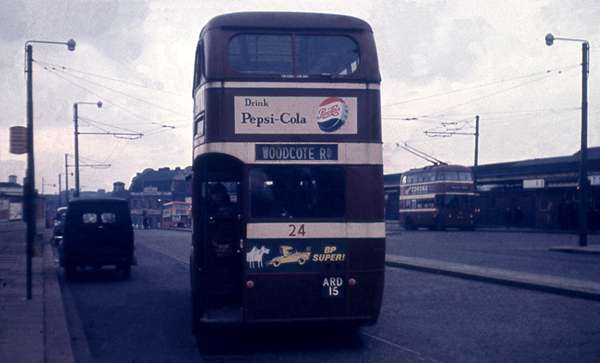
Reading Corporation AEC Regent/Park Royal no. 24 of 1938, taken by me at Reading
Station with a borrowed camera some time in 1957 or 58. This was the first batch of Reading Regents to be
fitted from new with A173 7.58-litre direct-injection engines. The view to the right of the picture has
changed dramatically over the past year: the same picture today would show the huge new
entrance-escalator-overbridge structure that has just opened to the public.
Interestingly, Reading Reliance no. 52, photographed and newly posted by Pete Davies, reused the number from
1936 Regent no.52, which carried a similar body, differing in a few details, and was fitted originally with
an indirect (Ricardo-head) engine, later converted to direct injection. That bus lasted only until 1950,
just before the Crossleys arrived. After its surprisingly short 14-year life with RCT it went to Yeomans of
Canon Pyon, Herefordshire. I don't know what happened to 24 after withdrawal on the last day of 1958, but it
was the last of our prewar motorbuses---though many of the 1939 AEC/Park Royal trolleybuses lasted until
1961.
Ian Thompson
10/10/13 - 17:02
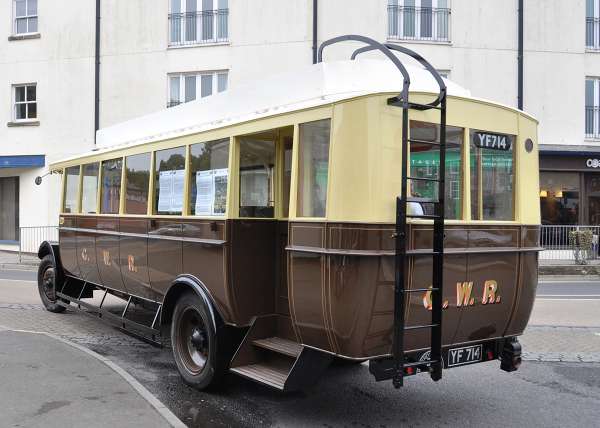
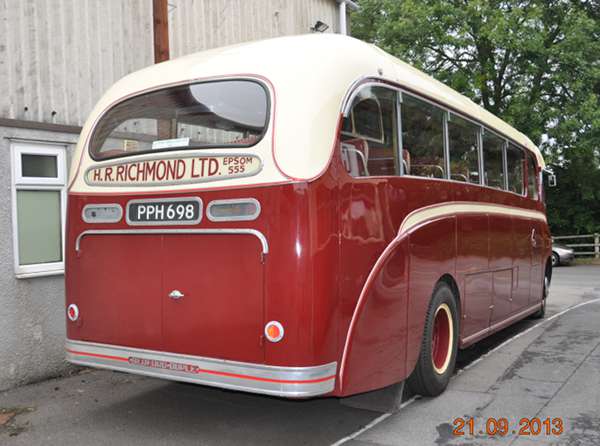
Here are a couple more shots for The Back End of the Bus article.
Ken Jones
23/10/13 - 17:20
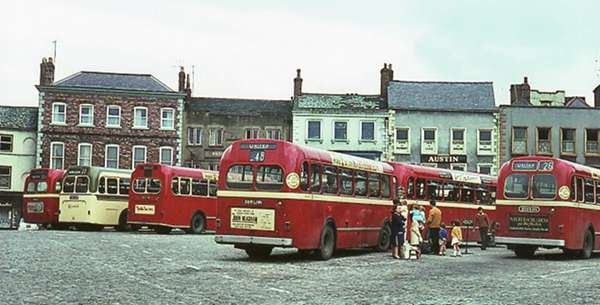
Here is a great line up of United Automobile Services Ltd Bristol saloons, all
showing their remarkable and ample rear ends.
Note the different Destination and livery layouts.
The location is Richmond (North Yorkshire), in case anybody thought it was the other one.
Stephen Howarth
24/10/13 - 09:33
Just dug out this shot of London's preserved ST 922, GJ 2098, an AEC Regent with a
Dodson or Tilling body from 1930. Quite some back end! Is this still a runner? If so, I wish it was still
running city tours like this when I took it in Piccadilly Circus in (probably) 1972.
Maybe this back end was the influence for the Borisbus?
Paul Haywood
25/10/13 - 07:56
Still very much a runner, Paul. Now residing at the Brooklands London Bus Museum, new, very swish, home of the Cobham Bus Museum. As a baby, I fell out of an aunt's arms off the back of one of LT's non-Tilling Regents. It is said that I was uninjured by the experience, but others have said that they aren't so sure!
Chris Hebbron
25/10/13 - 12:54
What a fine machine indeed, and I still have happy memories of a grand "public"
ride on it when it was operating I seem to recall service 100 from Trafalgar Square. I remember being
greatly impressed by the super comfort of the chunky well upholstered seats, and by the way it kept up very
well with the rest of the traffic. Admittedly Central London traffic is slow but nevertheless the
performance of the veteran petrol engined Regent was commendable. Looking back further to childhood days and
very regular visits to relations north and south of the Thames, plenty of petrol engines STs and LTs were
still in service - a different age just full of fascination and atmosphere.
Chris H - I think we can safely say that you were not harmed in any way by your dummy run (no pun intended)
in readiness for Boris's future baling out facility !!
Chris Youhill
26/10/13 - 07:26
A frontal view of ST922 is elsewhere on the website. In both photos, it's a pleasure to see the destination boards in use, something which quickly fell by the wayside when war broke out. It's also odd to see ST922 without serious body sag, which usually went with the post-war territory! These Tillings were in process of withdrawal/scrapping on the cusp of war, some becoming Home Guard weather protection during the 'Phoney War'. Unloved by LT, they were lent out in quantity to operators throughout the land, the last not returning to the fold until sometime in 1947. Most were scrapped upon return. In one of its bizarre moments, In about 1938, LT fitted one with an STL cab, not as a result of an accident. Why???
Chris Hebbron
16/11/13 - 08:51
As a 6-or-7-yr-old I was obsessed by open staircases, and would walk up to the bus
stop several minutes early in order to let enclosed-platform TD1s and other even more modern buses go by
just in case open-staircase TD1 no 36 (RD777) was on our route. Thames Valley also had some, but the fare
was at least a halfpenny more, so that was forbidden ground.
Twice I was lucky, and one blowy day I nearly lost my cap on the way up, but I don't remember the staircase
itself being at all alarming. The treads were generous and curved gently though ninety degrees.
The other day I was foolish enough to try to negotiate the stairs on a Scania Omnicity. The treads are all
irregular, some tapering to a nasty point, and the handrail is most unhelpful so I needed concentration and
good luck to get me to the top unscathed, but I heard the person behind me stumble.
What's happened to the Construction and Use regulations?
Ian Thompson
16/11/13 - 14:36
I couldn't agree more with your closing question there Ian. I travel with
trepidation on today's modern giants where emergency escape facilities are criminally inadequate. I refer
particularly to single doorway double deckers (an operational farce) holding upwards of ninety persons -
with any movement in the lower saloon virtually halted by oversized buggies opposite the bottom of the
stairs, and the inevitable "I'm only going a couple of stops" obstructionists in addition to perhaps
fourteen permitted standees. The almost laughable narrow "emergency exit" at the rear of the offside with
its lower half further rendered useless by a solid armrest for the long rear seat for five and by the
interlocking knees of the rearward facing 2 x 2 passengers. The thought of an engine fire, or a front
collision blocking the main door, causes me NOT to travel on them when they are completely full - and lets
not forget the multitude upstairs, forty plus, who are to all intents and purpose completely trapped.
As you so rightly say Ian - what has happened to effective Construction and Use regulations ??
Chris Youhill
16/11/13 - 15:28
Interesting observations, Chris. If there were to be- God forbid- a serious bus accident involving perhaps an overturn then there would be a flurry of hindsight as we get with so much else. You could make a simple start by bringing back the driver's door, which could act as an escape and give the driver more security, too.: he could lock down his cab and leave if attacked. Front exit is inherently unsafe anyway because today's heavy braking propels the passenger forward, and this means staircases have to be backwards, wasting much space. Front/Centre or just rear is better: why not bring back conductors, or these days there are plenty of ticketless, cashless systems. Why should we buy tickets on board? And another thing... why are (nearly) all buses so big? Many towns and suburban roads would be better with narrower shorter buses which fit bus lanes and towns better. Why "one size fits all"? Are they so unreliable that they have to move around? Rant subsides....
Joe
17/11/13 - 06:57
Spot on, Joe. Most buses nowadays are under-utilised in terms of capacity and some
are totally inappropriate for the services they operate.
Recently, myself and Chris Y had a trip from Knaresborough to Ripon on a Wright-bodied Scania. There were
never more than ten passengers on board at any point in the journey, but this large bus negotiated the very
narrow roads and tight bends of this 100% rural route at speeds which made us wince.
At one point, we came face to face with a bakery wagon which graciously reversed for what must have been a
quarter of a mile to allow us to pass.
On the journey, we speculated about the original United Autos L5G's which covered some of this route up to
the mid-1960s at speeds more appropriate to the lane widths and blind bends and, being probably a foot
narrower, untroubled by passing traffic.
Paul Haywood
20/11/13 - 08:27
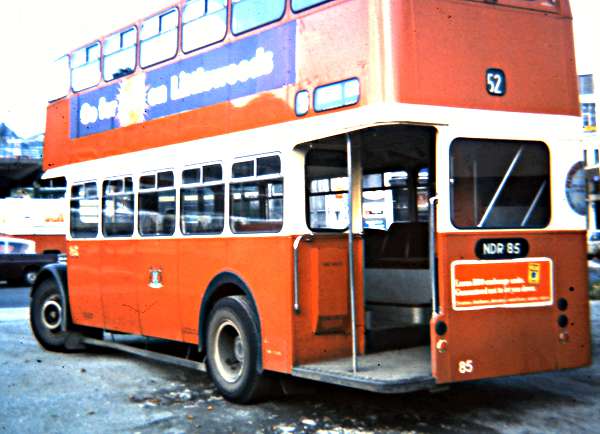
A photo taken when I was a lad and so proud of it at the time - PCT 85 NDR 85 a
Titan PD2/40 of 1957 with Metro Cammell H56R bodywork.
Yes it's out of focus and yes, it's really not very good but... it says a lot about what I remember of
Plymouth in the 50's & early 60's- lots and lots of Titans. I recall only variants of PD2's which dated from
1947 onwards - always in the livery shown here and always sounding just peachy.
By the way the camera was a Kodak Instamatic - anyone remember them?
Roger Ingle
20/11/13 - 09:29
Constructions & Use. I think the EU has thrown the rule book out of the window (where there are still opening windows!). Under certain circumstances - eg dual doors - a conventional emergency exit is no longer required. A bit like the new EU law which will allow those who passed their PSV/PCV test on an automatic vehicle to automatically (no pun intended) upgrade with out another test from January 2014. The ability to use a manual gearbox in a car does not presuppose the same ability in a PCV - even if one has years of experience in an automatic. Driving an old Dennis Javelin the other day brought this home to me. Manuals require more reading the road ahead and things like hill starts are not the same as in a car!
David Oldfield
20/11/13 - 11:23
Absolutely right David. It's many years since I've driven anything over 3 tonnes
but I know there is a marked difference as to the way I drive an automatic car in the USA, which I do
frequently, as opposed to my manual here in Ireland or in the UK. An automatic takes away a great deal of
the thinking required with a manual - though on an eight or ten lane highway where you can be overtaken on
either side and people swap lanes frequently, especially in the rush hour, there is a different requirement
for reading the road.
As far as hill starts go, I'm buying a new Hyundai i-40. This has an electronic handbrake and hill start
assist. These are becoming more commonplace. Add in a reversing camera with warning zones and the many of
the skill sets acquired in over 48 years of driving all sorts of vehicles are gradually becoming redundant.
I'm having a manual gearbox though as I want to retain some control!
Phil Blinkhorn
20/11/13 - 12:54
As a card-carrying VW man, Phil, I have driven a Passat with electronic handbrake. An interesting experience, but you soon get used to it. Spring Parking brakes are better now than they were initially - with a time delay to enable you to match clutch and throttle on a hill start. [Not a problem with semi or fully automatic transmission.] Likewise, I rather like the ZF AStronic automated (NOT automatic) box - which also appears in different guises by Mercedes, Volvo and Scania. The new version has been "sorted out" but the early ones were a bit of a b****r. They would roll back on hills and be a nightmare to reverse because you couldn't "trickle them" on tick-over revs like you can a conventional automatic. I would say the big success story of the last five years has been Hyudai/Kia. They are now making world beating cars.
David Oldfield
20/11/13 - 13:56
David, have you ever come across a ratchet handbrake? A frustrating experience trying to release one if you've never encountered one before.
Ronnie Hoye
20/11/13 - 15:46
On a bus, Ronnie? Oh yes. .....and how about on a Reliance when you had to remember to put your foot on the brake otherwise the hand-brake would not release.....
David Oldfield
21/11/13 - 05:45
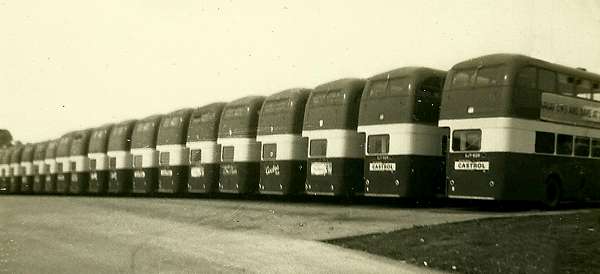
Further to Roger Ingle's picture of Plymouth 85 on the 'Back End of the Bus'
section, made me remember that I had this picture of a Plymouth line up, all showing their back ends.
I can count at least 18 vehicles. The one nearest the camera is GJY 939, the rest are too blurred to
identify.
The precision with which they are parked, and their cleanliness, would gladden the heart of any General
Manager and Fleet Engineer.
Stephen Howarth
21/11/13 - 09:41
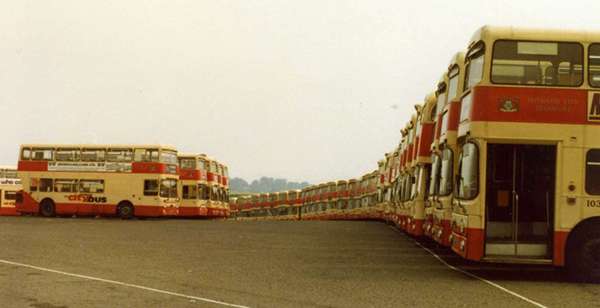
Stephen,
They certainly knew how to park buses in Plymouth.
This photo from 07/08/1983 shows 39 vehicles parked up at the Plymouth Argyle ground while reconstruction
work was being done at Milehouse depot.
Dave Farrier
21/11/13 - 14:57
Wouldn't have thought that this would gladden the heart of any groundsmen! Good photos, though.
Chris Hebbron
25/11/13 - 07:39

Attached is a not too good photograph of the rear of Hull's prototype "Coronation"
no. 101 running without retrievers - taken in July 1962 on Princes Avenue with my Brownie camera (oh for
digital cameras in those days!). The original design had the emergency door at the rear on the offside with
a single rectangular window at the back of the lower saloon. The Ministry of Transport rejected this and
insisted on the arrangement seen in the photo, despite the Transport Department pointing out that the
retriever ropes might foul the door opening.
I too am an advocate of a middle door for single deckers as I would not like to negotiate, in an emergency,
the collection of pushchairs, shopping bags with wheels and other obstacles that congregate at the front and
force everyone to the back of the phoney low floor buses with, in some cases, a large step up and a cramped
rear with very little leg room thanks to the wheel arches and the steep ramp. It's bad enough on normal
journeys. Who would want to jump out of the emergency door at its height into what could be a busy road? It
would be interesting to see an operator's risk assessment of this. Not that anyone will do anything about
it.
Malcolm Wells
16/12/13 - 09:20
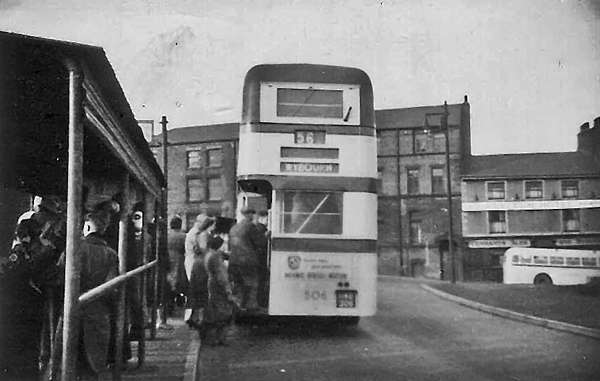
During the latter years of WW2, Sheffield received a motley collection of utility Daimlers and Guys bodied by various coachbuilders. Amongst these was number 506, a 1945 Daimler CWA6 with Brush H56R bodywork which was probably unique in having a full set of standard Sheffield destination gear at the rear ie a route number box above two horizontal destination indicators. Whilst a number of Leyland Atlanteans received three-part rear displays in the 1960's, none of these was strictly in the Sheffield formation. My apologies for the poor quality of the photo which was taken with my Brownie 127 about 60 years ago and was originally 2.5 inches by 1.5!
John Darwent
18/01/14 - 08:15
Halifax Corporation No 107 - FJX 507E which was new in 1967 a Daimler SRG6LX/33,
with Willowbrook B45F bodywork. It was transfered to West Yorkshire PTE on 1st April 1974 and took number
3107 in that fleet.
It would appear to be a body builders pre delivery image.
Stephen Howarth
18/01/14 - 12:43
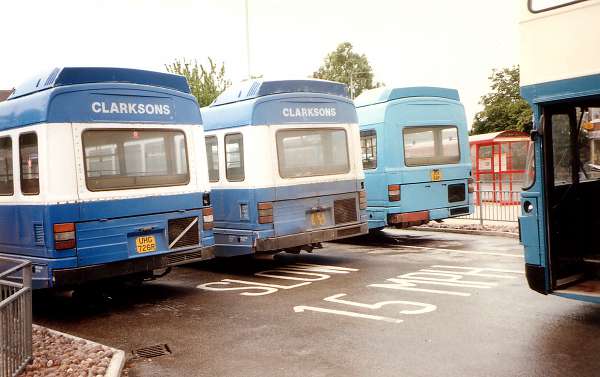
A shining example of Mrs. Thatcher's and Sir Nicholas Ridley's "Fair competition
for the benefit of the customers" Transport Act 1986 in operation.
This was one occasion in South Elmsall Bus Station when I was attempting to operate a long established and
perfectly adequate service with my ex West Riding Olympian - a splendid vehicle by then allocated to the
former SYRT depot at Pontefract and in British Bus colours as successor to the Caldaire Group. The drivers
of the three fine vehicles shown were enjoying one of their regular "competition" wheezes to brighten up
their day by preventing me leaving South Elmsall on time for the benefit of our long established passengers.
However, as soon as I appeared with my camera the scene changed dramatically - with a deafening clatter of
fixed head engines, screaming of giant fans, and the usual dense cloud of neat diesel smoke the bus station
became like the starting grid at Le Mans and I was able to set off for Pontefract.
Chris Youhill
19/01/14 - 08:12
Very well done, Chris. It will come as no surprise to regular perusers of these OBP pages that I hold the architects of the 1986 Transport Act in total contempt. Ridley possessed the anti Midas touch, turning pure gold into ashes with everything he handled - the Falklands, the Treasury, the Environment, Trade and Industry, and notably Transport. His profound ignorance on all these subjects disturbed him not one iota. The magical formula of 'free competition' in the bus industry turned out to be a licence for bullying and chaos on the premise that might is right. The ultimate result of 'liberating' the bus industry is that it is now dominated by five big groups rather than, as formerly, the NBC, numerous Independents and a multiplicity of Municipalities. These big groups have absolute regional monopolies, and are driven wholly by the slavish City pursuit of profit, and hence a stellar share price. Bus customers don't enter the equation at all, and, unlike air and rail, have no official body to look after their interests. The Traffic Commissioners no longer have any real sanctions against sloppy service standards. After a working lifetime in the bus industry, during which public transport was always my main mode of travel, I have given up on it entirely. I now use the car. The erratic 'service' of my local operator means that, on an hourly headway, if the bus fails for any reason, no replacement is put on; you just have to go on waiting for another hour. At 72 years of age, I don't know how much more time is going to be granted me, but I refuse to squander any of it 'Waiting for Souter'.
Roger Cox
19/01/14 - 08:15
There are lots of rear end photos of Park Royal buses here http://www.prv.org.uk/ (click on model name down the left hand side of the page), and some of Plaxton coaches here http://classicconnections.org.uk
Peter Williamson
19/01/14 - 11:22
Hear, hear Roger. I well remember Ridley seriously suggesting that the way forward in many British cities was the adoption of the Jitney/Jeepney system (a la Manila) where private (pirate?) operators would run an intensive and unregulated fleet of minibuses, stopping wherever a passenger hailed them. In those "Loads 'a Money" days, public transport was considered to be only needed by those unfortunate souls who couldn't afford a car - an ethos which still prevails in some quarters even today.
Paul Haywood
20/01/14 - 07:54
Love the story of the scramble out of your way Chris. Reminded me of the old 11.15pm Last Bus Whistle from Sheffield Pond Street Bus Station in days of old. Le Mans or what? www.youtube.com/watch
John Darwent
20/01/14 - 07:54
Sorry to correct you, Roger, but you used an outdated word that no longer has a relevance in the world of public transport. When I worked in the industry, buses were designated as 'Public service Vehicles' they have since been reclassified as 'Passenger Carrying Vehicles' and like the word, the 'Service' aspect has long since disappeared
Ronnie Hoye
20/01/14 - 08:48
Ronnie, at least in transport there is a degree of honesty. As someone who had responsibility for a number of call centres at various stages in his career and nearly 40 years ago wrote a manual which was used across a number of centres, many of which had nothing to do with me, I get really annoyed when dealing with today's so called Customer Service Centres or Help Lines or Assistance Lines. There is no dishonesty in their names, just in the implication, for they are only there to service the needs of the company managers by keeping you at arms length, blocked by low paid operatives with scant knowledge of the customers' rights or the law; they help themselves to their customers' cash by using non geographic phone numbers and the only assistance is in helping you to the edge of insanity by spouting company policy instead of using initiative and courtesy to solve your problem which, more times than not, has been caused by the lack of thought when designing their products, systems or rules. A generalisation I know but a reasonable reflection.
Phil Blinkhorn
20/01/14 - 10:31
Well do I remember the 2315 whistle at Pond Street - but my memories are the cream and blues, not the coffee and creams.
David Oldfield
20/01/14 - 11:35
Phil is quite right of course, and now local authorities have adopted the same
"customer service" approach where you cannot get direct access to anyone with a knowledge of the subject,
whether bus services, waste collection or road maintenance.
The term "customer helpline" is surely an oxymoron, like "Italian Beer Festival" or "US intelligence".
Geoff Kerr
20/01/14 - 11:40
Whilst agreeing that deregulation has been a disaster let us not pretend that there
was a golden age before it. What you had were absolute regional monopolies (BET and BTC)dead set on getting
subsidies for their networks, coordination agreements that had little to do with coordination and more to do
with mileage and receipt sharing and monopolist municipalities all of whom were struggling with falling
passenger numbers. In terms of efficiency and public service they varied widely. Anyone wanting to start a
bus service had these and the traffic commissioners ranged against them. Change was needed but not what we
got. In the late sixties when I used Hull Corporation buses on Friday nights buses on the service 73
regularly failed to turn up and a bus running empty from the service 10 circular terminus would roar past my
stop and KHCT refused to let that stop and pick up passengers.
Some areas now have regular bus surgeries - Hull arranges these on a very regular basis and both Stagecoach
and East Yorkshire attend. They also appear on local radio to answer callers' questions whilst passengers
can e-mail and tweet. There is a wide range of tickets available that were not in existence previously.
Passengers can get warning of service disruption on their mobiles.
No system is perfect so let us concentrate on enjoying the photographs and arguing'agreeing about the merits
of the varius chassis and bodies. I'll start by claiming there is no better rear of a bus the the Roe bodies
on Hull's Coronations!
Malcolm J Wells
20/01/14 - 16:10
No, it wasn't a 'Golden Age' before the 1985 Transport Act, but systems were in place that recognised the role of public transport in a fair and civilised society. A 'Certain Prime Minister' did not, as has often been attributed, coin the preposterous maxim that "Anybody seen in a bus over the age of 30 has been a failure in life" (it came from the dissolute poet Brian Howard), but it was a sentiment that ran strongly through the government of the time. The over protected status given to Road Service Licence holders under the 1930 Road Traffic Act (and complementary legislation up to the Transport Act 1968) was remedied by the Fowler Transport Act of 1980, which placed the weight of argument in favour of granting RSLs to those new applicants who could make a coherent case. Before this, the power lay with existing RSL holders, who could object to new applications unless 'need' could be irrefutably proven, an extremely difficult task. This liberated the Road Service Licensing system while still retaining the Traffic Commissioners' overall control. The role of local authorities in devising planned networks in consultation with bus operators could work extremely well in the right hands. As an example, the County of Surrey, notwithstanding its generally wealthy character, had a transport co-ordinator of outstanding merit, and the bus network reflected the cost efficient deployment of public funding in the public interest. Other counties showed rather more variable commitment, but the system was in place. Ridley tore it all up in favour of a free for all, and the utter chaos that ensued in built up areas was the inevitable result. Then followed the bully boy tactics, of which the Darlington episode was just one example among very many, and the present day scene emerged as a reflection of raw financial muscle, lacking any sensitivity to the needs of the bus user. On the subject of subsidy, it it apparently OK to support a privatised rail network to the tune of four times the cost of the old British Rail, but payment of public funds for bus services is somehow deplorable - except in London, of course, where extravagance and self advertisement at public expense is seemingly acceptable.
Roger Cox
20/01/14 - 17:00
Whilst I agree with most of what Roger says - Ridley was nigh on certifiable in his ideas and their implementation - I cannot let the comment about Darlington go unchallenged. Roger has his own unpleasant experiences which cannot be denied or belittled; but the fact remains - I repeat fact - that Stagecoach, and Go Ahead, are two of the best (and most moral - if an inanimate thing can be moral) transport groups in the world. Independent passenger satisfaction surveys repeatedly attest to this. At Darlington, the council were bust and about to close down and make everyone "redundent" - more correctly, just sack them. In desperation, the unions approached Sragecoach to take the workforce and operation over. There then followed some unseemly infighting with Frank Carter and with United whereby, not for the first time, Stagecoach were wrongly portrayed as a bully. [And no, I do not have, and never have had shares in Stagecoach.]
David Oldfield
21/01/14 - 06:32
John Darwants You tube video showing the Sheffield mass bus departure is great.
If the buses were painted Manchester Corporation Red and White, and North Western RCC Red and Cream then
that could be Manchester Piccadilly at 23:00.
There was one tale which abounded in Manchester at the time that one particular Guard on a passing bus
leaned off the platform and blew his whistle at 2 minutes to 11. This meant of course that all the buses
left early. Apparently the Inspector was left totally bemused, and was hopping mad, because he had missed
the bus he was going to catch home.
How true it is I do not know, but it is the sort of thing that happened, in the good old days.
Stephen Howarth
21/01/14 - 06:32
Sorry, David, but that is a less than comprehensive assessment of the Busways aka
Stagecoach activities in Darlington. The Competition Commission ruled:-
"It was the combination of Busways' actions in recruiting so many of DTC's drivers so quickly, registering
services on all its routes and running free services which caused DTC's final collapse. We find these
actions to be predatory, deplorable and against the public interest." It took the view that Stagecoach had
deliberately operated locally at a loss in order to eradicate Darlington Transport as part of a wider
campaign to take on United in the town. Stagecoach clearly has its admirers, but as one who has worked for
it, and who has to suffer its inadequacies as a local bus operator, I am not numbered amongst them.
Roger Cox
18/03/14 - 11:22
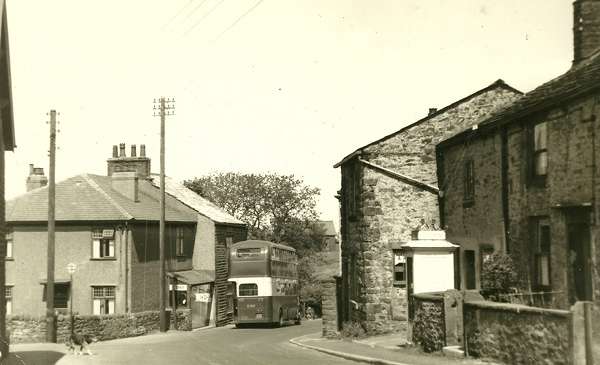
Attached is a picture (recently acquired off ebay), for the Back End of a Bus
section.
I thought it could go in that section, but there is also a question to go with it.
Where is it?
The bus itself is from Blackburn Corporation Transport Department. The Registration
is CBV 430 - Fleet No.130, a Guy Arab 6LW Chassis No.FD28402 with a Crossley H30/26R body. It was received
by Blackburn on 26th May 1949, but not placed into service until 1st July 1949. It was withdrawn on 16th May
1973, after a very creditable 24 years service.
I have obtained all the above information from the excellent website 'Olive Green and Ivory' - a History of
Blackburn Tramways and Omnibuses, the link to that site is www.olivegreenandivory
Stephen Howarth
18/03/14 - 13:57
The location could be Tockholes, looking towards Blackburn. If it is where I
suspect, the Victoria Hotel will be to the right of the bus.
I have to question some of the withdrawal dates given on the website referred to. It is my recollection that
the last eight Crossley-bodied Guys and the first four of the 1961 Arab IVs (with 'Johannesburg' bonnets)
were displaced by new Atlanteans 81-92 in late 1972 - I was working for Blackburn Transport at the time.
Four of the 1961 Guys were withdrawn in preference to buses of the previous batch (140-57) at the request of
the Deputy Manager, David Clark.
It is further my recollection that the last eight Crossley-bodied Guys in service were 131/3-9 - the
implication being that 130 had gone earlier.
David Call
28/03/14 - 09:00
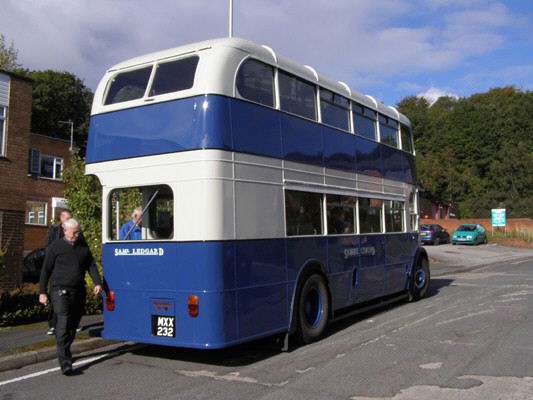
Preserved London Transport AEC Regent III / Weymann RLH32 (MXX232) in Ledgard livery, a most handsome bus if ever there was one, shows off its rear at the Samuel Ledgard Centenary celebrations on Saturday 13th October 2012.
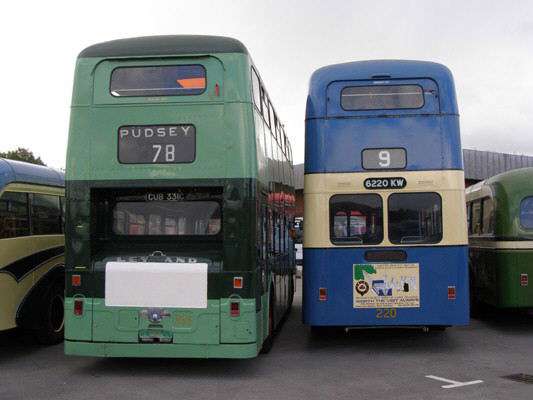
The second photo was taken at the same event, contrasting the rear of Leeds CT 1965 Leyland Atlantean PDR1/1 (Mk2) / Weymann 331 (CUB331C) with that of Bradford CT 1964 AEC Regent V / MCW 220 (6220KW).
Brendan Smith
28/03/14 - 17:44
Thanks, Brendan for the Leeds & Bradford posting. What though, is the white rectangle under the "Ley and" (sic) badge (something redacted?)... and does the camera lie or is that green wrong? Fussy Atlantean rear and nice solid Bradford Regent with classy backlit numberplate and matching "stopping" sign. I always preferred the pale blue Bradford livery, though, or was it just faded?
Joe
30/03/14 - 07:54
The Leeds Atlantean is in the one man livery and as far as memory serves me is in the correct shades. The white patch was something that occasionally appeared on Leeds buses but I don't know why. The Bradford blue did have a tendency to fade often to an almost pastel shade.
Chris Hough
30/03/14 - 18:19
Joe, the white panel on the Atlantean's rear hasn't been redacted at all, but was actually on the vehicle. I had just assumed it was in preparation for a signwritten advert at some point in the future perhaps. It does tend to draw the eye in the picture though, although I was oblivious to this at the time, captivated as I was by the charm of the buses. Chris H's comment about similar white panels occasionally appearing on LCT buses could relate to something along similar lines maybe. As Chris also mentions, BCT's blue did have a tendency to fade over time, sometimes quite markedly, but from memory the Regent does seem to be in the right shade of blue.
Brendan Smith
31/03/14 - 07:17
Thanks Brendan. The white patch is curious because it seems to mask the top of the
Atlantean badge. It could be a vinyl panel I suppose applied because the advert's time was up, and in true
Yorkshire style, they were not getting owt for nowt.
The green mystery thickens. If you review all the Leeds photos on this site it does look like two shades of
green: one pepperminty like this or 380 and other ?yellower? versions like 980 or 221. My memory is more the
latter than the former.
Joe
12/07/14 - 08:42
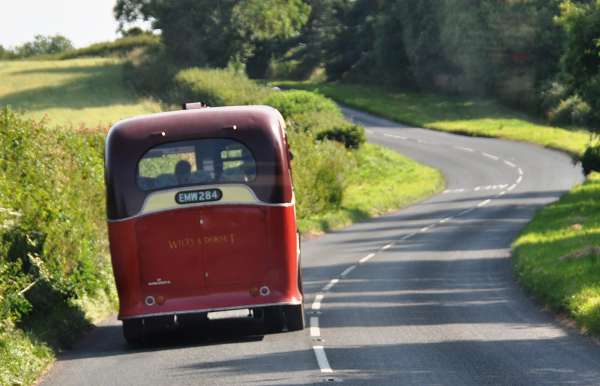
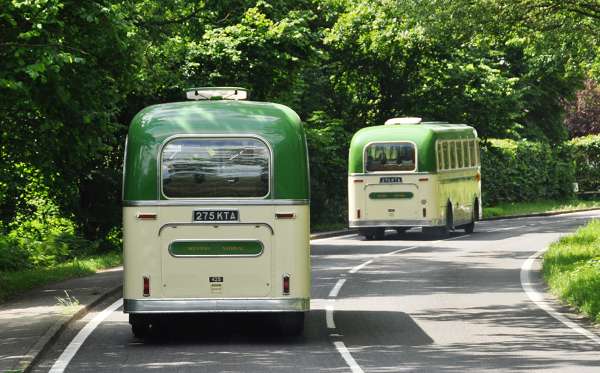
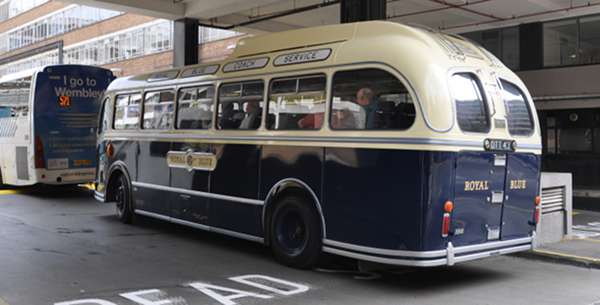
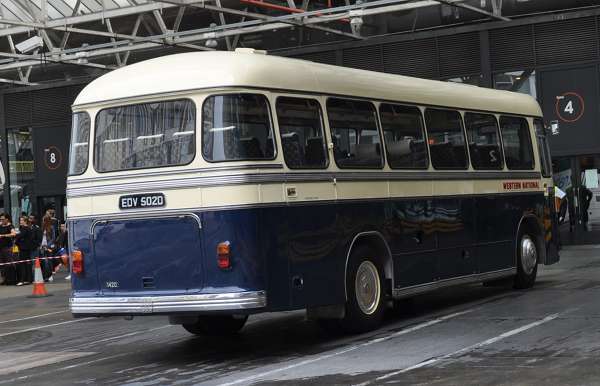
Here are some shots of the back end of buses taken during the Royal Blue run of June this year.
Ken Jones
Comments regarding the above are more than welcome please get in touch via the 'Contact Page' or by email at
If you have a bus related article that you would like to appear on this site please get in touch via the 'Contact Page' or by email at
All rights to the design and layout of this website are reserved Old Bus Photos does not set or use Cookies but Google Analytics will set four see this
Old Bus Photos from Saturday 25th April 2009 to Sunday 25th February 2024